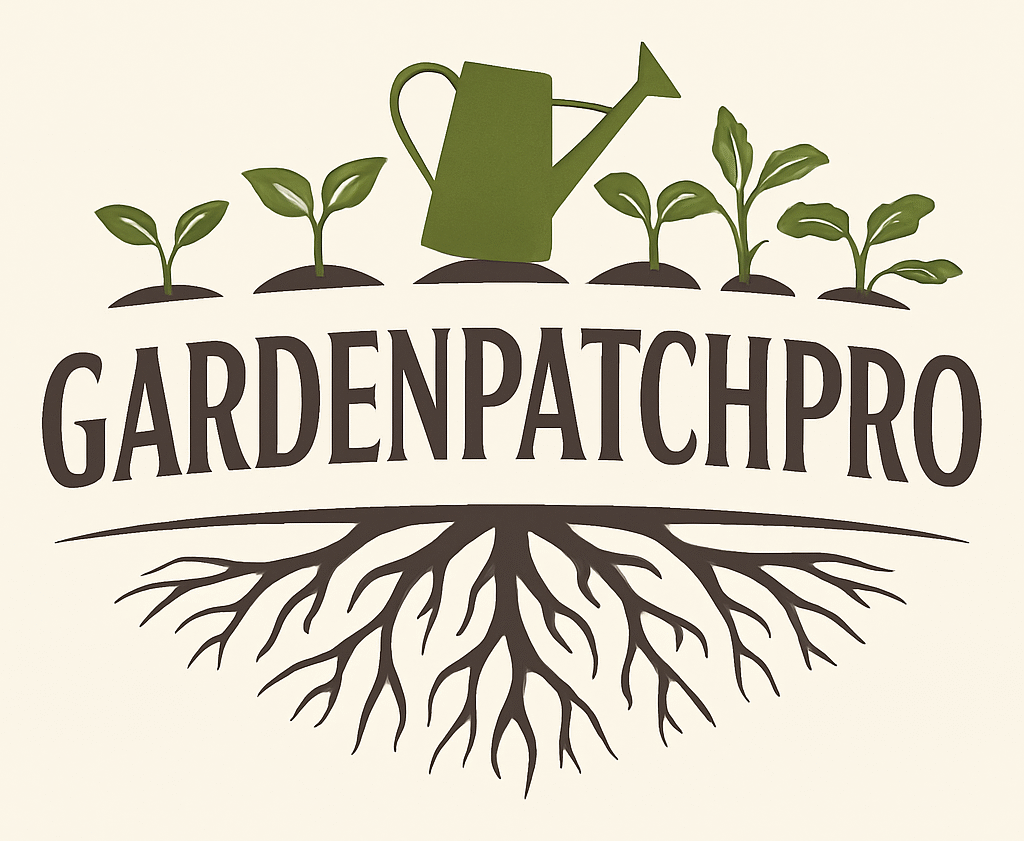Controlling Garden Pests Naturally: Effective Strategies for Every Gardener
Controlling garden pests naturally means using safe, effective methods that avoid harsh chemicals. A healthy garden with balanced soil and strategic plant choices can keep many pests away without pesticides. Natural pest control focuses on prevention and encourages helpful wildlife like birds and beneficial insects to protect plants.
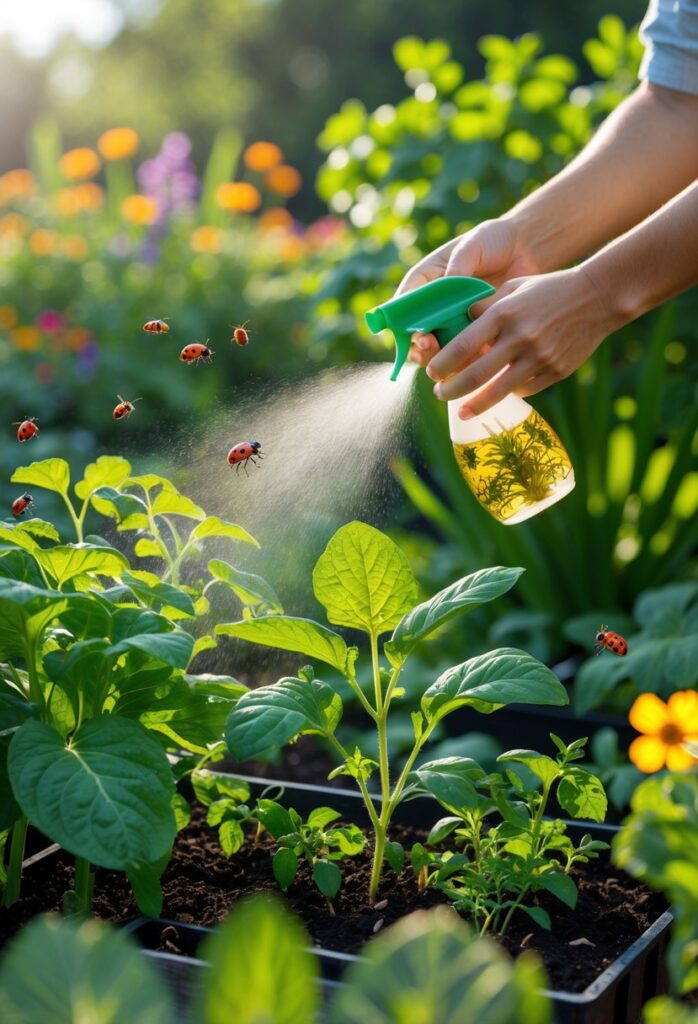
There are many ways to manage pests, including companion planting, homemade sprays, and physical barriers. These techniques work together to keep damaging insects and animals from harming vegetables and flowers. By understanding the habits of common pests, gardeners can create a thriving space that relies on nature’s balance.
Using natural pest control methods not only protects plants but also supports the overall health of the garden ecosystem. This approach promotes sustainable gardening that is better for both the environment and the gardener’s peace of mind.
Key Takeways
- Healthy soil and smart planting prevent many garden pest problems.
- Beneficial animals and companion plants help reduce harmful insects.
- Simple natural sprays and barriers protect without dangerous chemicals.
Understanding Common Garden Pests
Garden pests come in many forms, from tiny insects to larger critters. Knowing how to spot them and understanding their habits helps gardeners protect their plants effectively.
Identifying Common Pests
Several pests are common in gardens and cause damage by eating leaves, stems, or roots. Aphids and mealybugs are small, sap-sucking insects that cluster on new growth. Spider mites are tiny and create webbing on plant undersides. Whiteflies look like small white moths and fly around when disturbed.
Larger pests like slugs and snails leave slimy trails and chew holes in leaves, especially in damp conditions. Beetles, including Japanese beetles, eat leaves and flowers and are often metallic in color. Caterpillars and hornworms consume large amounts of foliage and can quickly defoliate plants.
Other pests include ants, which farm aphids, and squash bugs that attack squash plants, causing wilting and yellow leaves. Recognizing these pests early can help prevent major damage.
Pest Behavior and Life Cycles
Understanding how pests behave and reproduce can guide effective control. Many garden insects, like aphids and whiteflies, reproduce quickly and can form large colonies in weeks. They feed by sucking plant juices, weakening plants over time.
Slugs and snails are mostly active at night and hide during the day in moist, shaded areas. They lay eggs in soil or under debris, which hatch in a few weeks.
Beetles and caterpillars go through complete metamorphosis: egg, larva, pupa, and adult stages. For example, Japanese beetles lay eggs in the soil, and larvae feed on grass roots before emerging as adults. This cycle often lasts one season.
Spider mites prefer dry, hot weather and reproduce rapidly. Knowing when pests are most active allows gardeners to time interventions for the best results.
Integrated Natural Pest Management
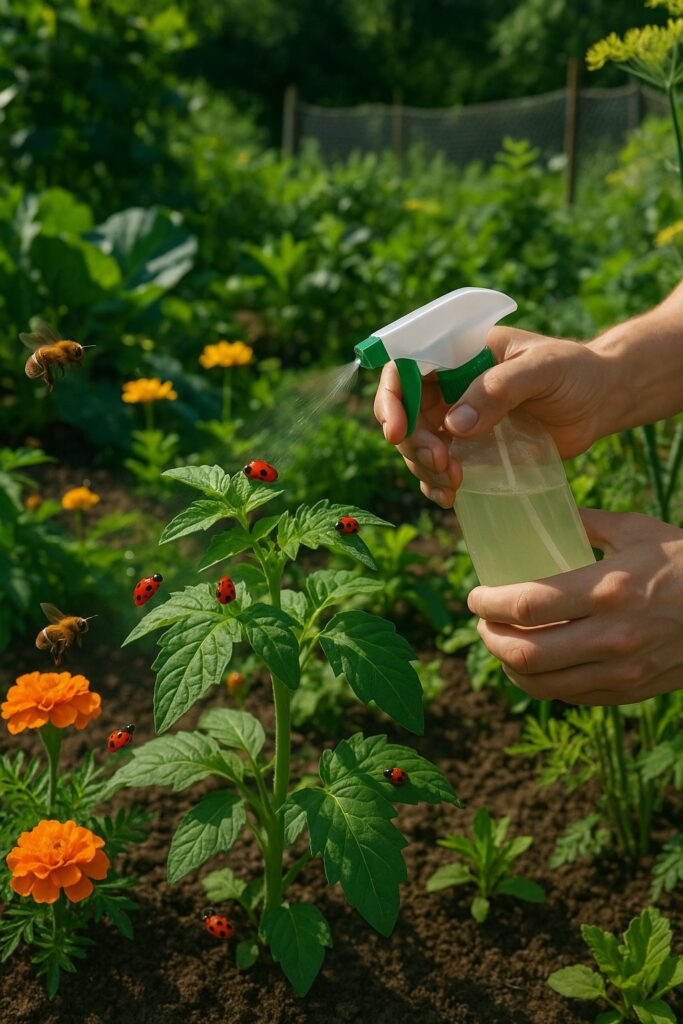
Controlling garden pests naturally involves careful planning and using multiple methods. It focuses on keeping pests at manageable levels without harming beneficial insects, plants, or the environment. Successful natural pest management uses observation, prevention, and selective controls to maintain a balanced garden ecosystem.
Principles of Natural Pest Control
Natural pest control starts with understanding pest life cycles and their roles in the garden. Gardeners monitor pest populations regularly to identify problems early. They allow some pests to remain since total elimination can harm helpful insects like ladybugs and bees.
The approach uses biological controls such as introducing or encouraging natural enemies like predatory insects or birds. Cultural methods include crop rotation, plant selection, and maintaining healthy soil to reduce pest pressure.
Mechanical strategies, like handpicking pests or using barriers, help control without chemicals. The goal is to manage pests in a way that minimizes disruption to the garden ecosystem while protecting plants effectively.
Reducing Reliance on Harsh Chemicals
Reducing the use of harsh chemicals helps protect beneficial insects and the wider environment. Chemical sprays can quickly kill pests but also harm pollinators and natural predators, leading to pest resistance.
Instead, gardeners use chemicals only when necessary, choosing targeted and least-toxic options. Early detection allows small infestations to be treated before they grow, often with less harmful methods.
Combining prevention, such as selecting pest-resistant plants and improving soil health, lowers pest outbreaks. This reduces the need for heavy pesticide use and supports long-term pest control success in a natural garden setting.
Learn more about integrated approaches to pest management from the NC State Extension Gardener Handbook.
Cultural and Preventive Gardening Practices

Controlling pests naturally starts by creating conditions that make the garden less attractive to harmful insects. This includes careful planning of plant placement, managing soil health, and controlling moisture levels. These steps reduce pest problems before they begin.
Companion Planting Strategies
Companion planting uses certain plants to protect others from pests. For example, marigolds release chemicals that repel nematodes and some insects. Basil can deter mosquitoes and flies, while nasturtiums act as a trap crop by attracting aphids away from vegetables like tomatoes and peppers.
Flowering plants such as yarrow and sweet alyssum attract beneficial insects like ladybugs and lacewings, which prey on pests. Onions and mint also have pest-repelling properties when grown near susceptible plants. These combinations improve biodiversity and support a balanced ecosystem in the garden.
By mixing plants wisely, the gardener reduces pest damage without chemicals. This method fits with sustainable gardening by encouraging natural pest control and promoting plant health.
Crop Rotation and Plant Diversity
Crop rotation involves changing the location of plants each year to disrupt pest life cycles. Nightshades like tomatoes and peppers benefit from this, as pests that attack their roots or leaves cannot build up over time.
Including diverse plant families, such as brassicas and legumes, enhances soil health by reducing nutrient depletion and disease risks. Rotating crops helps maintain fertile, healthy soil strengthened by organic matter like compost and mulch.
This practice lowers pest populations linked to specific plants and supports long-term garden productivity. Crop rotation combined with plant diversity reduces dependence on pesticides and keeps the garden ecosystem more balanced.
Proper Watering for Pest Prevention
Watering correctly prevents many pest issues by avoiding overly wet or dry conditions favorable to insects and diseases. Early morning watering allows foliage to dry during the day, which lowers fungal growth that weakens plants.
Using drip irrigation targets water at the roots, preventing moisture buildup on leaves where pests like spider mites thrive. Overwatering can encourage soft plant growth, which attracts pests such as aphids.
Maintaining moisture levels that match the needs of specific plants supports strong, healthy growth and improves resistance to pests. Proper watering is a simple, effective cultural practice that helps sustain both plant vigor and soil quality.
Learn more about these techniques in the context of sustainable gardening at natural pest control in the garden.
Biological Controls and Beneficial Organisms

Using living organisms to control pests helps reduce damage without harmful chemicals. Natural predators and beneficial insects play key roles. Gardeners can attract and support these helpers by providing food and shelter to keep their population steady and effective.
Attracting Natural Predators
Natural predators such as birds and ground beetles help manage pest numbers. Birds feed on many insects that damage plants, so planting small trees and shrubs creates safe places for them to live and nest. Ground beetles thrive under mulch or stones near garden beds, where they hunt for pests.
Using diverse plants that bloom at different times gives natural predators a steady source of nectar and pollen. Avoiding pesticides also protects these helpful animals. Gardeners can offer water sources like shallow dishes to encourage birds and insects to stay.
Encouraging Beneficial Insects
Beneficial insects like ladybugs, lacewings, and parasitic wasps are effective at controlling pests like aphids. Ladybugs and lacewing larvae actively hunt and consume pest insects. Parasitic wasps lay eggs inside pests, reducing their numbers naturally.
To encourage these insects, gardeners should plant nectar-rich flowers such as dill, fennel, and marigolds. These flowers provide essential food and habitat. Avoid strong chemicals that kill both pests and beneficial insects. Releasing purchased ladybugs or lacewings can also boost control efforts when pest problems start.
Building Biodiversity in Your Garden
A garden with many plant types supports a healthy community of pest predators. Mixing vegetables, flowers, and herbs creates hiding spots and food sources throughout the year. This variety helps sustain populations of beneficial insects and natural predators.
Using cover crops or leaving some areas wild can support ground beetles and other ground-dwelling predators. Creating natural spaces discourages pest outbreaks by keeping predator-prey relationships balanced. Biodiversity makes a garden more resilient and easier to protect without chemicals.
For more about using natural enemies for pest control, see Biological Control – Pests in gardens and landscapes – UC IPM.
Physical and Mechanical Pest Barriers
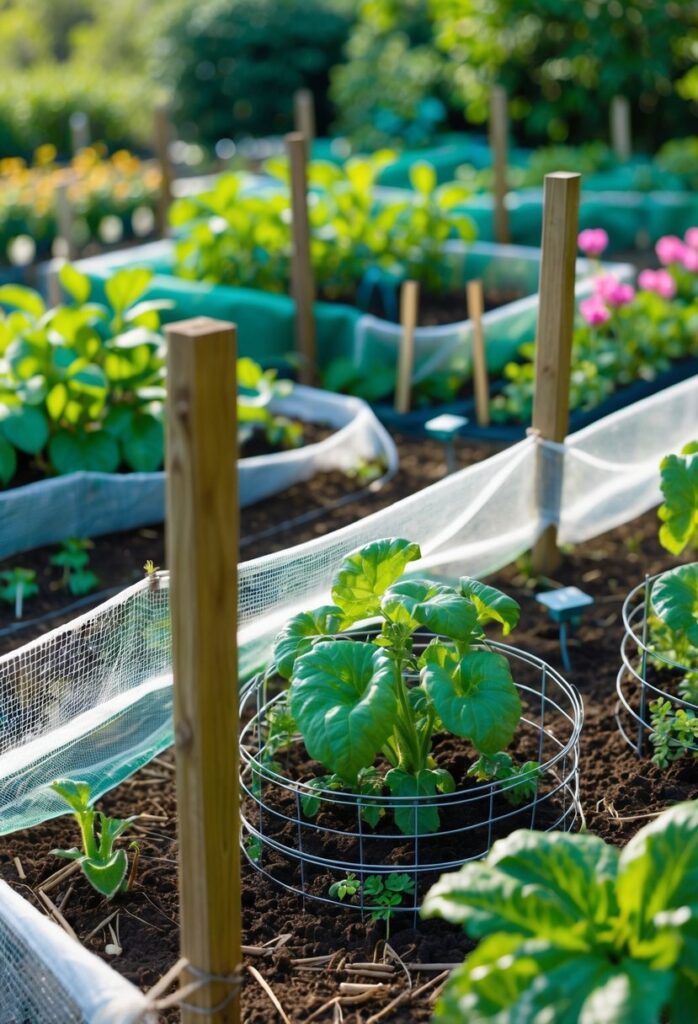
Physical and mechanical methods form a strong defense against garden pests by creating clear obstacles that insects and animals cannot easily cross. These methods include fabrics and meshes that block insects, organic materials that discourage pests, and specially designed traps for ground pests. Together they reduce pest damage without chemicals.
Using Row Covers and Netting
Row covers are lightweight fabrics placed over plants to block insects like aphids and beetles while allowing sunlight, air, and moisture to reach the crops. They are usually held up by stakes or hoops to avoid touching the plants directly. It is important to maintain ventilation to prevent moisture buildup, which can cause fungal problems.
Netting works well for keeping larger pests, such as birds and bigger insects, off fruits and vegetables. The netting should be secured properly at the soil line to stop animals from crawling underneath. Both row covers and netting can be removed easily when plants require maintenance or harvesting, making them flexible physical barriers for pest control.
Mulch and Traps as Physical Deterrents
Mulch, like straw or wood chips, helps keep soil moist and supports beneficial insects that prey on pests. Certain mulches can also repel specific pests indirectly by creating unfavorable environments. Placing mulch around plants creates a physical layer pests must cross, which slows them down.
Traps target specific pests such as insects or rodents. Sticky traps catch crawling or flying insects, while baited traps lure mammals away from plants. Using traps in combination with other barriers improves overall pest control by physically removing pests rather than just blocking them.
Barriers for Slugs and Snails
Slugs and snails cause damage by feeding on leaves and stems. Physical barriers such as copper tape are effective because the metals react with their slime, creating a mild electric charge that repels them. Placing copper tape around pots or beds forms a clear boundary they avoid crossing.
Another useful method is applying diatomaceous earth, a powder made of fossilized algae. It has sharp edges that irritate slugs and snails when they crawl over it, discouraging their movement. Creating dry zones with coarse materials can also reduce slug and snail populations by depriving them of moist hiding spots.
Natural and Homemade Pest Remedies
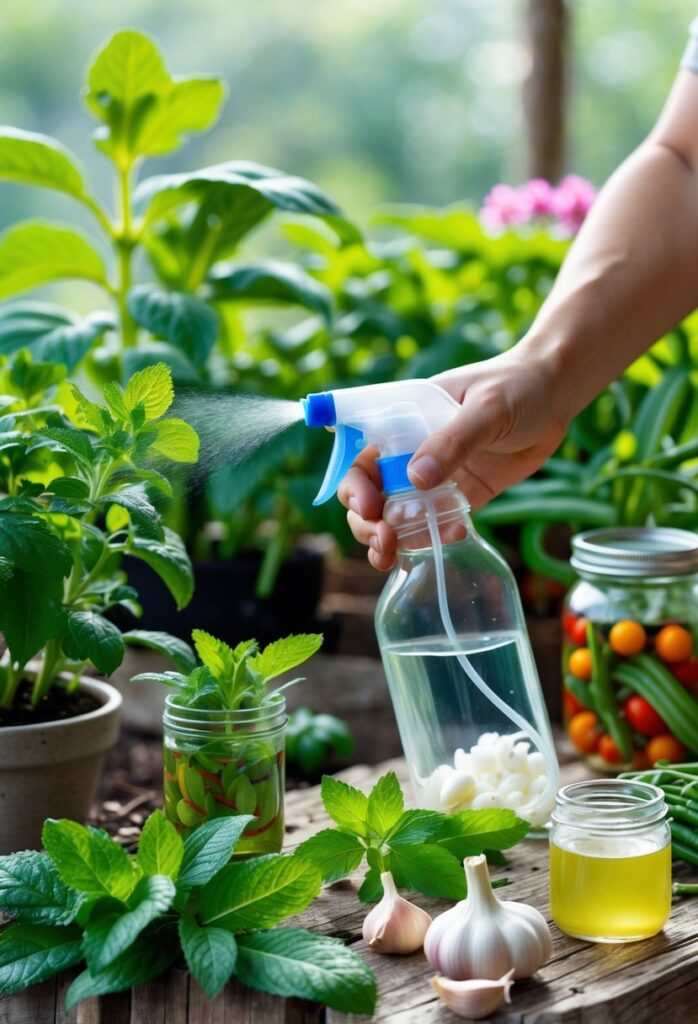
Effective natural pest remedies often use common ingredients that target insects without harming the plants or beneficial wildlife. These treatments can control many garden pests and can be applied safely with simple tools. Using these remedies regularly helps keep gardens healthy.
Neem Oil Applications
Neem oil is a natural pesticide extracted from the neem tree. It works by disrupting the feeding and breeding of many insects like aphids, whiteflies, and spider mites. When sprayed on plants, neem oil coats the leaves and makes them unappealing to pests.
To use neem oil, mix it with water and a small amount of mild liquid soap to help it spread evenly. Apply the spray in the early morning or late evening to avoid leaf burn. Neem oil is biodegradable and safe for most beneficial insects, such as bees, when used correctly. It also helps prevent fungal diseases, giving plants extra protection.
Insecticidal Soap Sprays
Insecticidal soap sprays are made from natural fatty acids that break down the outer layers of soft-bodied insects like aphids, mealybugs, and thrips. These soap sprays kill pests on contact without harming the plants.
Gardeners can buy ready-made insecticidal soap or create their own by mixing a few teaspoons of pure liquid dish soap with water. Spray directly on affected areas, including the undersides of leaves. It’s best to reapply every few days and after rain for continued protection.
Avoid soaps with added fragrances or harsh chemicals. Insecticidal soap sprays are safe to use around children and pets when used as directed.
Garlic and Herbal Sprays
Garlic sprays act as a natural insect repellent. The strong scent confuses and deters a variety of pests like aphids, caterpillars, and beetles. Gardeners often blend garlic cloves with water and sometimes add onion or hot peppers for extra strength.
To make the spray, crush 4-5 garlic cloves and steep them in water overnight. Strain the liquid and transfer it to a spray bottle. Spray it around plants and on leaves, focusing on pest-prone areas.
Herbal sprays using ingredients like mint, rosemary, or chili peppers can also help repel insects. These sprays work by masking the smell of plants or irritating pests directly. Reapplication every 7-10 days is usually needed for best results.
Natural Insect Repellents
Natural insect repellents include plant-based substances and simple household ingredients that keep pests away without killing them. They often rely on strong smells or textures that insects dislike.
Examples include planting companion herbs such as basil, rosemary, or tansy near vegetables to deter pests naturally. Sprinkling diatomaceous earth around plants creates a rough border that bugs avoid. Garden lime can repel larger animals like raccoons and deer when spread around garden edges.
Using natural repellents helps maintain a balanced garden ecosystem. These methods can be combined for better results and used alongside other pest control techniques for a chemical-free garden.
For more tips on natural pest control, see this detailed list of natural pest control methods for gardeners.
Frequently Asked Questions

Natural pest control in gardens includes using household items, plant extracts, and companion plants to reduce or eliminate unwanted insects. Simple sprays, oils, and planting strategies can protect crops without chemicals. Organic vegetable growing also relies on careful pest management techniques to maintain healthy plants.
What are effective home remedies for managing garden pests naturally?
Common home remedies include sprays made from garlic, hot peppers, and onions. These mixtures repel aphids, caterpillars, and beetles. Diatomaceous earth sprinkled on soil acts as an abrasive barrier against soft-bodied insects.
How can neem oil be used as a natural solution for pest control in gardens?
Neem oil disrupts the life cycle of many pests by affecting their feeding and reproduction. It can be mixed with water and sprayed directly on leaves. Regular application helps control aphids, whiteflies, and spider mites without harming beneficial insects.
Can you provide a DIY organic pest control recipe for home gardens?
A simple spray combines 2 teaspoons of liquid dish soap with warm water in a spray bottle. Adding chopped hot peppers and garlic can boost its effectiveness. This mix can be applied to leaves and stems to deter a range of pests.
What methods are recommended for pest management in organic vegetable cultivation?
Organic vegetable growers use companion planting, crop rotation, and handpicking pests. Introducing beneficial insects like ladybugs and installing physical barriers such as row covers help prevent infestations. Maintaining healthy soil also reduces pest problems.
What plants can be integrated into a vegetable garden to function as natural pest deterrents?
Plants like marigolds, basil, rosemary, and nasturtiums repel insects and protect vegetables. Garlic and onions planted near fruit trees or berry bushes stop borers and beetles. Petunias help keep Colorado potato beetles away from beans and potatoes.
What are some proven natural strategies for eliminating pests from gardens without using chemicals?
Techniques include attracting pest-eating birds, using garden lime around plant beds, and scattering dried blood meal to deter deer and rabbits. Placing chopsticks or plastic forks in soil discourages digging by cats and dogs. Companion planting and homemade sprays add layers of protection.
Learn more about these approaches in the article on how to combat garden pests naturally.
